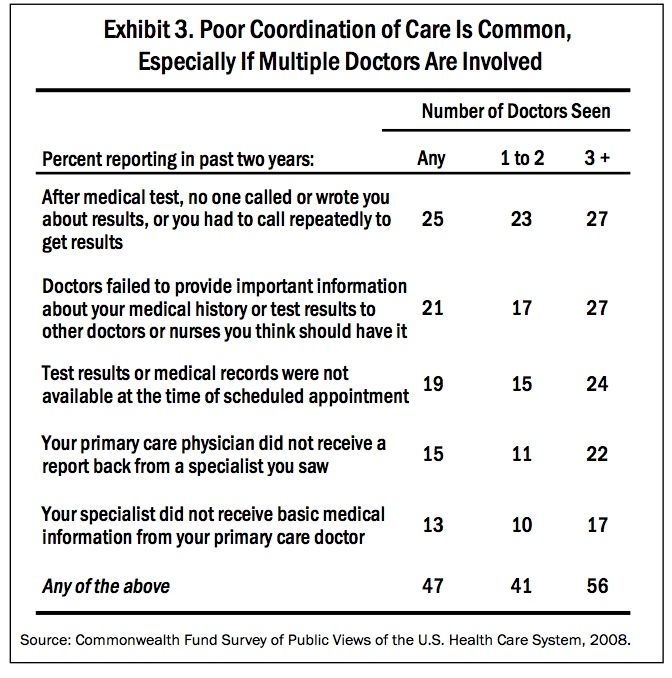Healthcare Coordination Has Got to Get A Lot Better. Here's How It Can.
Care coordination has long been an Achilles heel of the American healthcare industry. Gone are the days when personal relationships among practitioners and organizations were enough to ensure clear communications and hand-offs as patients made their way through the system. These days, the process is fraught with miscues, crossed signals and inefficiencies. It leaves patients struggling to understand their conditions, their treatment options, their care instructions and their payment responsibilities. It drives up costs for providers and payers. It increases the risk of medical mistakes and compromises the quality of care.
As the Improving Chronic Illness Care (ICIC) organization puts it, “Across U.S. health care, fragmented systems and communication breakdowns contribute to widespread failures in care coordination that have devastating consequences for patients.
Need further confirmation? Just ask the patients themselves, as the Commonwealth Fund did in this survey:

Those experiences ring just as true now as they did when the survey was conducted in 2008. The situation is unsustainable, especially with the industry’s current shift to value-based reimbursement models that emphasize better outcomes at lower cost. Poor care coordination is a big obstacle standing in the way of those efforts. Clearly, something’s got to give.
Teamwork: The Missing Ingredient
Care coordination has been defined as “the deliberate organization of patient care activities between two or more participants (including the patient) involved in a patient’s care to facilitate the appropriate delivery of health care services.” In other words, it’s all about cross-functional connections and teamwork, and that’s where the system so often falls short. While individual healthcare professionals may do an admirable job attending to their separate areas of responsibility, the cracks between them are wide enough for all sorts of important details to fall through. That’s true even within single practices and clinical settings, and it gets much worse when a patient’s care spans multiple organizations and environments (acute, ambulatory, out-patient, home care and aftercare).
Several factors in particular contribute to the problem:
- Current healthcare systems are often disjointed, and processes vary among and between primary care practices (PCPs) and specialty sites.
- There is often no central point of responsibility for the entire cycle of care.
- Many organizations don’t have sufficient people or systems dedicated to care coordination.
- Much of the time and labor that goes into care coordination is not reimbursed.
Why New Collaborative Solutions Are Needed
It’s critical for healthcare organizations to invest in new solutions that bridge the gaps and support better coordination. Electronic Health Records (EHR) systems being adopted by major healthcare institutions are a start, but they’re not nearly enough, as a recent report by Frost and Sullivan made clear. Though EHRs are helping to eliminate disconnects and discrepancies in patient records, they don’t provide the dynamic collaboration and communication capabilities needed to make collective decisions, fully orchestrate care and make sure all participants are informed and on the same page. They capture records of clinical decisions that were made, but they’re missing a lot of the essential context around those decisions – the conversations and communications that are such an important piece of the process. Decisions made by different care teams can conflict, and without robust information on why decisions were made, physicians can be left guessing.
What’s really needed is a digital collaboration platform where all stakeholders can come together to share information, make care decisions, track progress and make adjustments as necessary. Such a platform serves as a hub for coordinated care, solving many of the issues described above. A clinical hub:
- Creates accountability by bringing the entire care team into a collaborative environment.
- Provides clinical alerts, reminders and messaging to the entire care team.
- Bridges the gap between care providers and makes it easier to consider all aspects of a patient’s condition beyond the EHR.
- Provides a way to easily manage the conversations associated with transitions of care, keeping all caregivers on the same page. Specialists consistently receive clear reasons for the referral or adequate information on tests that have already been done.
- Helps scale your existing care coordination resources to provide increased service to more patients, improving aggregation, analysis, and communication of patient information.
Of course, the collaborative platform has must comply with all rules and regulations (such as HIPAA and HITECH), and it must be secure. It should be easy for people to access and use via mobile devices, not just computers, since clinicians spend much of their time away from their desks. And it should tightly integrate with other essential tools and systems, such as secure texting and clinical communication systems, learning management tools and IT ticketing systems.
A successful clinical collaboration hub can dramatically improve care transitions and make the process better for everyone involved. By powering better collaboration, a hub reduces costly missteps, enables more timely decisions and actions, and cuts down on duplication and confusion. It eliminates many of the frustrations of disconnected processes and increases satisfaction not only for patients but also the caregivers themselves. It drives greater value across the entire spectrum of care. And most importantly it leads to healthier patient outcomes and the best care experience possible.
Learn how a clinical collaboration hub can improve care coordination for your organization.
GET A PERSONALIZED DEMO
See how Jive works. Request a personalized demo.
See for yourself how Jive can drive productivity and engagement across your organization. Get a free personalized demo.